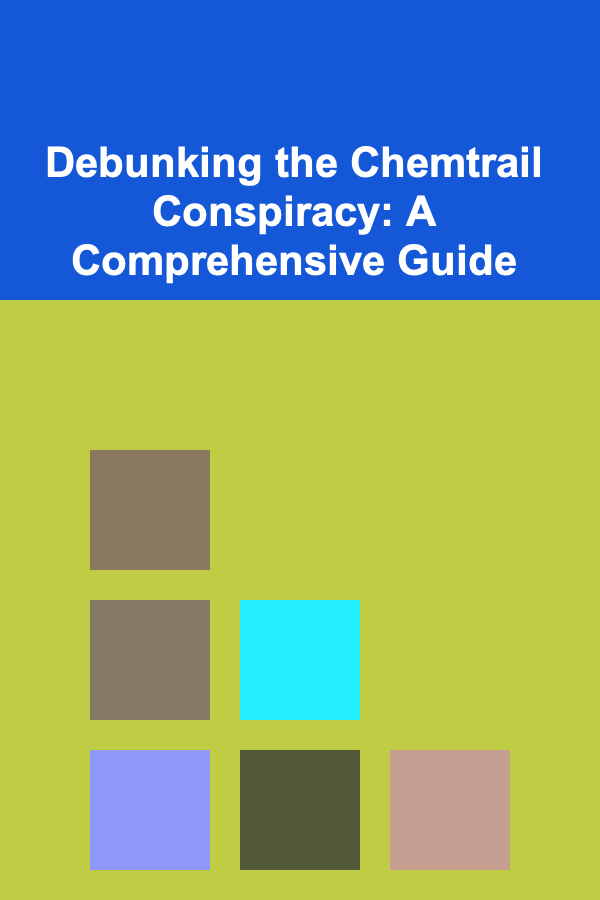
Debunking the Chemtrail Conspiracy: A Comprehensive Guide
ebook include PDF & Audio bundle (Micro Guide)
$12.99$8.99
Limited Time Offer! Order within the next:

The "chemtrail" conspiracy theory, which posits that long-lasting condensation trails ("contrails") left by aircraft are actually chemical or biological agents being deliberately sprayed for nefarious purposes, has persisted and even grown in popularity despite overwhelming scientific evidence to the contrary. While the conspiracy has evolved over time, its core tenet remains the same: that governments and/or secret organizations are engaged in a large-scale atmospheric spraying program, often with alleged motives ranging from weather modification and population control to military experimentation and environmental manipulation. This article aims to provide a comprehensive and evidence-based debunking of the chemtrail conspiracy, exploring its origins, dissecting its claims, and offering strategies for engaging with those who believe in it.
Understanding the Chemtrail Conspiracy: Origins and Evolution
The chemtrail conspiracy emerged in the late 1990s, shortly after the publication of a 1996 US Air Force report titled "Weather as a Force Multiplier: Owning the Weather in 2025." This report, which explored theoretical possibilities for weather modification, was quickly seized upon and misinterpreted by conspiracy theorists. They argued that the report was not merely a theoretical exercise but a confirmation of ongoing clandestine operations. The key trigger, however, was the increasing prevalence of persistent contrails in the sky, particularly those that spread out and formed cirrus-like clouds. These were interpreted not as normal contrails, but as "chemtrails" -- trails of chemicals intentionally dispersed into the atmosphere.
Over the years, the chemtrail conspiracy has incorporated various other narratives and anxieties. It has been linked to concerns about geoengineering, particularly solar radiation management (SRM), which involves the deliberate injection of aerosols into the stratosphere to reflect sunlight and cool the planet. While SRM is a legitimate area of scientific research, proponents of the chemtrail theory often conflate it with their perceived evidence of ongoing spraying, arguing that chemtrails are either a precursor to or a component of a larger geoengineering program. Furthermore, the conspiracy has been associated with fears about population control, new world order ideologies, and shadowy government agendas. The supposed ingredients of chemtrails vary widely, from barium and aluminum to viruses, polymers, and even genetically modified organisms. This variety reflects the adaptability of the conspiracy and its ability to incorporate new anxieties and concerns.
The Science of Contrails: What Are They Really?
To understand why the chemtrail conspiracy is unfounded, it's crucial to understand the science of contrails. Contrails are simply condensation trails, formed when hot, humid exhaust from aircraft engines mixes with the cold, low-pressure air of the upper atmosphere. This mixing causes water vapor in the exhaust to rapidly condense and freeze, forming ice crystals that create visible trails. The persistence of contrails depends on the ambient atmospheric conditions, particularly the humidity and temperature at flight altitude.
Several factors influence the persistence of contrails:
- Humidity: If the air is sufficiently humid (close to saturation with respect to ice), the ice crystals in the contrail will persist and even grow as they absorb moisture from the surrounding air. This leads to long-lasting contrails that can spread out and form cirrus clouds.
- Temperature: Contrails are more likely to form in cold temperatures, typically below -40°C (-40°F). These temperatures are commonly found at altitudes where commercial aircraft fly (around 30,000-40,000 feet).
- Engine Efficiency: While less significant than humidity and temperature, engine efficiency can also play a role. Engines that produce more water vapor in their exhaust may lead to slightly denser contrails.
- Air Traffic Density: Increased air traffic naturally leads to more contrails, and areas with high air traffic volume (like major flight corridors) are more likely to experience persistent contrails.
The increasing observation of persistent contrails is not evidence of a secret spraying program, but rather a consequence of several factors, including the growth in air travel, changes in engine technology, and possibly shifts in atmospheric conditions due to climate change. Scientific studies have shown that contrails can significantly impact regional climate, contributing to both warming (by trapping outgoing infrared radiation) and cooling (by reflecting incoming solar radiation). This impact is an active area of climate research, but it is distinct from the claims of the chemtrail conspiracy.
Dissecting the Claims: Why They Fall Apart
The chemtrail conspiracy is based on a series of claims that are easily refuted with scientific evidence and logical reasoning.
Claim 1: "Chemtrails" are chemically distinct from contrails.
Debunking: Proponents of the chemtrail theory often claim that "chemtrails" contain unusual substances like barium, aluminum, strontium, or polymers. They often cite anecdotal evidence, such as soil samples taken near areas with heavy contrail activity that allegedly show elevated levels of these substances. However, these claims are easily debunked.
First, the levels of barium, aluminum, and other elements found in soil and water samples are often within the normal range for those substances in the environment. Aluminum, for instance, is the most abundant metallic element in the Earth's crust and is naturally present in soil, water, and air. Elevated levels of aluminum can be attributed to various sources, including industrial activity, natural weathering of rocks, and even common fertilizers.
Second, numerous scientific studies have analyzed air samples taken in and around contrails. These studies have consistently found that contrails are composed primarily of water ice crystals, with trace amounts of soot and other combustion products from jet fuel. There is no credible scientific evidence to support the claim that contrails contain unusual or dangerous chemicals. A particularly important study, published in 2016 in the journal Environmental Research Letters, surveyed 77 atmospheric scientists and geochemists and found that 76 of them (98.7%) reported no evidence of a secret large-scale atmospheric spraying program. The remaining scientist, while unable to definitively rule out the possibility, emphasized the lack of compelling evidence. [Shearer, C., Westfall, P., Caldeira, K., & Davis, S. J. (2016). Quantifying expert consensus against the existence of a secret, large-scale atmospheric spraying program. Environmental Research Letters, 11(8), 084011.]
Third, the very idea of spraying large quantities of these substances from aircraft is impractical and easily detectable. Releasing tons of barium or aluminum into the atmosphere would require a massive logistical operation involving specially designed aircraft, storage facilities, and a large workforce. Such an operation would be virtually impossible to conceal and would inevitably be detected by air traffic controllers, airport personnel, and other aviation professionals. Furthermore, the dispersal mechanisms required to evenly distribute these substances would be easily identifiable and would leave a distinct signature in radar and other atmospheric monitoring data.
Claim 2: Contrails used to disappear quickly, but now they persist for hours.
Debunking: As mentioned earlier, the persistence of contrails depends on atmospheric conditions. The observation of more persistent contrails is not evidence of a change in the composition of the trails, but rather a reflection of changes in atmospheric humidity and temperature. Increased air traffic also contributes to the increased visibility of contrails. Furthermore, the perception that contrails used to disappear quickly may be a result of selective memory and the increased awareness of contrails due to the spread of the conspiracy theory itself. People who believe in chemtrails are more likely to notice and remember persistent contrails, reinforcing their pre-existing beliefs.
Moreover, historical records and photographs dating back to the early days of aviation show that persistent contrails have been observed for decades. These historical observations predate the emergence of the chemtrail conspiracy, further undermining the claim that persistent contrails are a recent phenomenon associated with secret spraying programs.
Claim 3: The grid-like patterns of contrails are evidence of deliberate spraying.
Debunking: Aircraft typically fly along designated flight paths, which are often organized in grid-like patterns to optimize air traffic flow and safety. These patterns are dictated by air traffic control and are publicly available. The observation of contrails along these flight paths is simply a result of aircraft following established routes, not evidence of a coordinated spraying operation. The perceived "grid" is a visual artifact of looking up at intersecting flight paths from a ground-based perspective.
Furthermore, weather patterns and wind shear can also distort contrails, creating irregular shapes and patterns that may appear unusual or unnatural. These distortions are simply a result of natural atmospheric processes and are not indicative of intentional manipulation.
Claim 4: Government documents and patents prove the existence of chemtrails.
Debunking: Proponents of the chemtrail theory often cite government documents, patents, and scientific research related to weather modification, geoengineering, and aerosol spraying as evidence of a chemtrail program. However, these documents are invariably misinterpreted or taken out of context. For example, patents for aerosol spraying technologies describe potential applications for a variety of purposes, such as cloud seeding, crop dusting, and even military applications. These patents do not prove that these technologies are being used for nefarious purposes or that they are related to contrails.
Similarly, scientific research on geoengineering, particularly solar radiation management, is often conflated with the chemtrail conspiracy. While geoengineering research explores the potential for using aerosols to mitigate climate change, it is a highly regulated and transparent field of study. Geoengineering experiments are conducted under strict ethical and environmental guidelines and are subject to peer review and public scrutiny. There is no evidence to suggest that geoengineering research is being secretly implemented through a chemtrail program. The "Weather as a Force Multiplier: Owning the Weather in 2025" document, frequently cited by conspiracy theorists, is merely a theoretical exploration of future possibilities and does not describe any actual operational programs.
Claim 5: Whistleblowers have come forward to expose the chemtrail program.
Debunking: While individuals have occasionally claimed to be whistleblowers with inside knowledge of the chemtrail program, their claims have consistently been debunked. These individuals often lack credible evidence to support their allegations, and their stories are often riddled with inconsistencies and inaccuracies. In many cases, their claims can be traced back to misinformation and disinformation campaigns originating from unreliable sources. Furthermore, the lack of corroborating evidence from other sources and the absence of any credible documentation further undermine the credibility of these purported whistleblowers.
Genuine whistleblowers typically provide verifiable documentation, witness testimony, and other forms of corroborating evidence to support their claims. In contrast, the alleged chemtrail whistleblowers often rely on anecdotal evidence, speculation, and unsubstantiated claims. Their motivations are also often questionable, with some individuals seeking attention, notoriety, or financial gain through their association with the conspiracy theory.
Engaging with Believers: A Strategy for Effective Communication
Debunking the chemtrail conspiracy is not just about presenting scientific evidence; it's also about understanding the psychological and social factors that contribute to belief in the conspiracy. Many people who believe in chemtrails are genuinely concerned about environmental issues, government transparency, and public health. They may feel alienated or distrustful of mainstream institutions and seek answers from alternative sources of information. Therefore, a respectful and empathetic approach is crucial when engaging with chemtrail believers.
Here are some strategies for effective communication:
- Listen actively and empathetically: Before attempting to debunk the conspiracy, take the time to listen to the person's concerns and understand their perspective. Acknowledge their anxieties and validate their feelings, even if you disagree with their beliefs. This will help build trust and create a more open and receptive environment for discussion.
- Focus on specific claims and provide evidence-based rebuttals: Avoid making broad generalizations or dismissing the person's beliefs outright. Instead, focus on specific claims and provide credible scientific evidence to refute them. Cite peer-reviewed studies, expert opinions, and government reports to support your arguments. Explain the science of contrails in a clear and accessible manner, avoiding technical jargon.
- Address the underlying anxieties and concerns: Recognize that belief in the chemtrail conspiracy may be rooted in deeper anxieties about environmental degradation, government corruption, or loss of control. Address these underlying concerns directly by providing information about relevant issues, such as climate change, pollution, and government transparency. Offer constructive solutions and empower the person to take action to address these issues.
- Be patient and persistent: Changing someone's mind about a deeply held belief can be a slow and challenging process. Don't expect to convince them overnight. Be patient, persistent, and respectful in your communication. Provide information and resources that they can explore on their own. Plant seeds of doubt and allow them to come to their own conclusions.
- Avoid confrontational or condescending language: Using confrontational or condescending language will only alienate the person and reinforce their beliefs. Instead, adopt a respectful and collaborative tone. Frame your arguments as a friendly discussion, rather than a debate. Acknowledge that reasonable people can disagree on complex issues.
- Highlight the scientific consensus: Emphasize that the overwhelming majority of scientists agree that contrails are simply condensation trails and that there is no evidence of a chemtrail program. Cite surveys and studies that demonstrate the scientific consensus on this issue.
- Encourage critical thinking and media literacy: Promote critical thinking skills and media literacy to help people evaluate information more effectively. Encourage them to question the sources of information, to look for evidence-based arguments, and to be wary of unsubstantiated claims and conspiracy theories.
- Lead by example: Demonstrate your own commitment to evidence-based reasoning and critical thinking in your daily life. Be open to changing your own beliefs when presented with compelling evidence. This will help build trust and credibility with those who hold different views.
The Broader Context: Conspiracy Theories and Distrust
The chemtrail conspiracy is just one example of a broader phenomenon: the proliferation of conspiracy theories in the modern world. Conspiracy theories often arise in times of uncertainty, anxiety, and social upheaval. They provide a sense of order and control in a chaotic world by offering simple explanations for complex events. They also appeal to people who feel alienated or disenfranchised from mainstream institutions and seek alternative sources of information and belonging.
The internet and social media have played a significant role in the spread of conspiracy theories. These platforms allow for the rapid dissemination of misinformation and disinformation, and they create echo chambers where people can reinforce their existing beliefs and avoid exposure to alternative perspectives. Algorithms that prioritize engagement over accuracy can further exacerbate the problem by promoting sensational and controversial content, including conspiracy theories.
Addressing the problem of conspiracy theories requires a multi-faceted approach that includes promoting critical thinking skills, media literacy, and scientific literacy. It also requires building trust in institutions and fostering a more open and transparent society. Furthermore, it is essential to address the underlying anxieties and concerns that drive people to embrace conspiracy theories in the first place. This may involve addressing issues such as economic inequality, political polarization, and environmental degradation.
Conclusion: The Importance of Reason and Evidence
The chemtrail conspiracy is a baseless belief that is unsupported by scientific evidence. Contrails are simply condensation trails formed by aircraft exhaust, and the claims that they contain dangerous chemicals are easily refuted. Addressing the chemtrail conspiracy requires a combination of scientific debunking, empathetic communication, and a broader understanding of the psychological and social factors that contribute to belief in conspiracy theories. By promoting reason, evidence, and critical thinking, we can help to combat the spread of misinformation and build a more informed and rational society.
Reading More From Our Other Websites
- [Home Budget 101] How to Save Money on Your Home's Water Bill with Simple Adjustments
- [Small Business 101] How to Navigate International Shipping Logistics for Small E‑Commerce Sellers
- [Mindful Eating Tip 101] Best Mindful Eating Rituals for Couples to Strengthen Their Relationship
- [Weaving Tip 101] Organizing Threads, Yarns, and Accessories: Storage Solutions for Weavers
- [Personal Finance Management 101] How to Set Up a Savings Plan for Your Child's Education
- [Home Soundproofing 101] How to Reduce Echo in Your Home with Simple Soundproofing Tips
- [Trail Running Tip 101] Your First Trail Run: A Step-by-Step Guide for New Runners
- [Personal Finance Management 101] How to Create a Financial Safety Net for Your Family
- [Organization Tip 101] How to Develop a Routine for Maintaining Your Fitness Area
- [Small Business 101] How to Start a Small Business: Key Legal and Financial Considerations

How to Organize Your Receipts for Easy Budgeting
Read More
Lowering Motorcycle Insurance Premiums: 7 Simple Ways to Cut Costs
Read More
Make Money with AI: How Deep Learning Can Help
Read More
How To Explore Quantum Computing for Machine Vision
Read More
How To Start Wine Tasting: A Beginner's Guide
Read More
Exploring Staking and Yield Farming: A Comprehensive Guide
Read MoreOther Products

How to Organize Your Receipts for Easy Budgeting
Read More
Lowering Motorcycle Insurance Premiums: 7 Simple Ways to Cut Costs
Read More
Make Money with AI: How Deep Learning Can Help
Read More
How To Explore Quantum Computing for Machine Vision
Read More
How To Start Wine Tasting: A Beginner's Guide
Read More